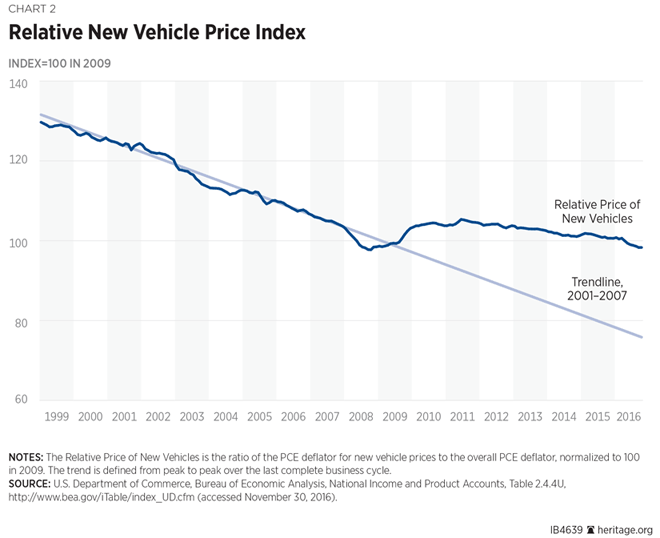In 2016, two scholars from the Heritage Foundation, Salim Furth and David Kreutzer, wrote a paper titled Fuel Economy Standards Are a Costly Mistake that revealed that from the late 1990s through 2009, the quality-adjusted price of new cars was falling. However, upon the imposition of new, strict fuel economy regulations by President Obama, this trend reversed and the cost of new vehicles started to increase. In fact, by 2016, the Heritage scholars found that the price of the average car had risen to $6,200 above the previous trend. This was bad, but things got even worse after 2016.
Back in 2016, these scholars created this chart below showing the trendline of decreases in new vehicle prices and then the imposition of Obama’s fuel economy mandates in 2009.

In the waning days of the Obama administration, the administration reviewed the fuel economy regulations for model year 2022-2025 and despite the evidence presented by the Heritage Foundation, the Obama administration said the fuel economy regulations were still appropriate and should be continued. The Trump administration then came along and found that the 2022-2055 standards were “not appropriate and, therefore, should be revised” and revised the 2022-2025 regulations.
Since then, the Biden administration then unleashed a tripled-pronged attack to force much higher fuel economy regulations and, within a few years, a switch to electric vehicles. The regulations come from the Environmental Protection Agency, the National Highway Traffic Safety Administration, and the state of California (to understand these complex regulations, the Congressional Research Service has an explanation here, and we explain EPA’s here, NHTSA’s here, California’s here).
The results of these regulations and inflation have resulted in an affordability crisis for new vehicles. Below is the Consumer Price Index for new cars from 1999 through 2024 (with the index set at 100 in 2009, to make it comparable to the graphic from Heritage above). The Obama regulatory-driven increase post-2009 looks quaint to the recent regulatory and inflationary increase in the price of new vehicles.

Kelley Blue Book estimates the average transaction price of a new vehicle is now $48,389. That is up from $39,259 when President Biden was elected in November 2020—an increase of 23 percent.
It is certainly true that the rapid increase in car prices on President Biden’s watch is not 100 percent caused by his fuel economy regulations. Some of the increase in vehicle prices is also attributable to the inflation that his policies have helped fuel, as well as supply chain issues caused by the policies pursued during the pandemic.
If President Biden wants to reduce the price of new cars, he would roll back his fuel economy regulations that EPA, NHTSA, and California are working to impose. A 23 percent increase in new vehicle prices is shocking. These prices are hurting the affordability of mobility for American families.



